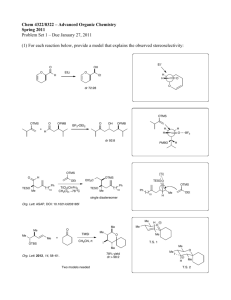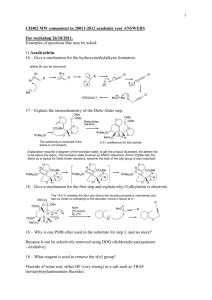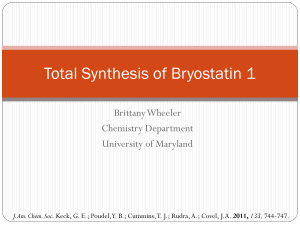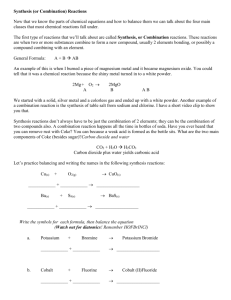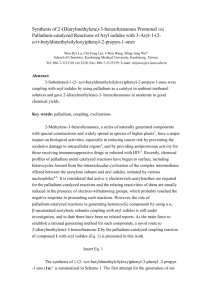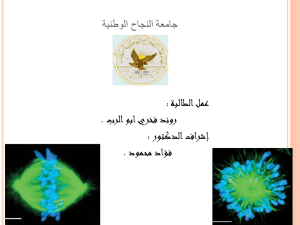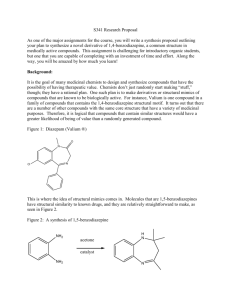Microsoft Word
advertisement
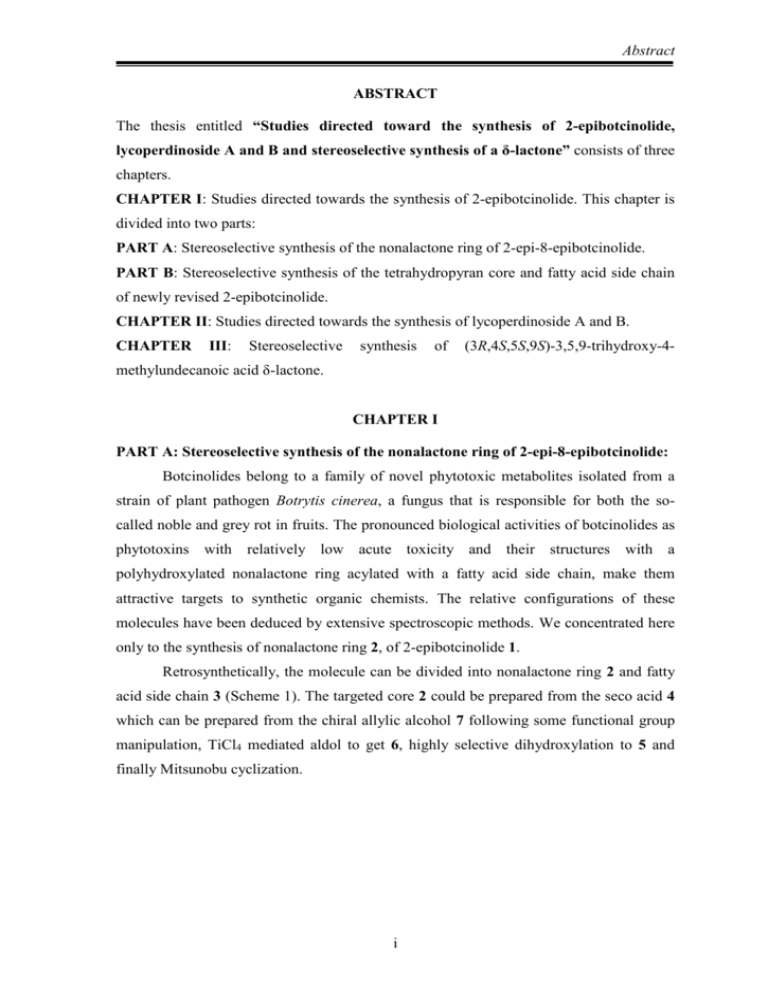
Abstract ABSTRACT The thesis entitled “Studies directed toward the synthesis of 2-epibotcinolide, lycoperdinoside A and B and stereoselective synthesis of a δ-lactone” consists of three chapters. CHAPTER I: Studies directed towards the synthesis of 2-epibotcinolide. This chapter is divided into two parts: PART A: Stereoselective synthesis of the nonalactone ring of 2-epi-8-epibotcinolide. PART B: Stereoselective synthesis of the tetrahydropyran core and fatty acid side chain of newly revised 2-epibotcinolide. CHAPTER II: Studies directed towards the synthesis of lycoperdinoside A and B. CHAPTER III: Stereoselective synthesis of (3R,4S,5S,9S)-3,5,9-trihydroxy-4- methylundecanoic acid δ-lactone. CHAPTER I PART A: Stereoselective synthesis of the nonalactone ring of 2-epi-8-epibotcinolide: Botcinolides belong to a family of novel phytotoxic metabolites isolated from a strain of plant pathogen Botrytis cinerea, a fungus that is responsible for both the socalled noble and grey rot in fruits. The pronounced biological activities of botcinolides as phytotoxins with relatively low acute toxicity and their structures with a polyhydroxylated nonalactone ring acylated with a fatty acid side chain, make them attractive targets to synthetic organic chemists. The relative configurations of these molecules have been deduced by extensive spectroscopic methods. We concentrated here only to the synthesis of nonalactone ring 2, of 2-epibotcinolide 1. Retrosynthetically, the molecule can be divided into nonalactone ring 2 and fatty acid side chain 3 (Scheme 1). The targeted core 2 could be prepared from the seco acid 4 which can be prepared from the chiral allylic alcohol 7 following some functional group manipulation, TiCl4 mediated aldol to get 6, highly selective dihydroxylation to 5 and finally Mitsunobu cyclization. i Abstract O O PMBO OH OH O O OH O + OH OTBS OTES OTBS O OH 1 3 2 OTES OH OH HO 2 O OTBS O BnO O OTBS OPMB 4 TBSO OH OH O PMP 5 OTBS BnO BnO OH 7 O OH 6 Scheme 1 Benzylation of commercially available methyl (S)-3-hydroxy-2-methylpropionate (8) with O-benzyl-trichloroacetimidate under acidic condition was followed by reduction of ester with LAH to provide the chiral alcohol 9. Oxidation of 9 gave an aldehyde, which OH MeO O OH BnO 8 9 OTBS O 12 BnO OTBS BnO BnO COOEt 10 11 CHO OTES BnO 6 OH O TIPSO OTES OTES BnO + OH TIPSO O 13 BnO TIPSO 14 OH 14a Scheme 2 was subjected to Wittig olefination using the stabilized ylide Ph3P=C(CH3)CO2Et to furnish the E-olefin 10 exclusively. Compound 10 was next transformed into the aldehyde 11 in two steps- reduction with LAH to an alcohol followed by oxidation to the aldehyde. Aldol reaction of 11 with the titanium enolate derived from the chiral ketone 12 gave the desired syn isomer 6 as the major product in 6:1 ratio. The product was purified and silylation of the allylic hydroxyl was carried out followed by protective group ii Abstract manipulation, necessitated in order to achieve selective deprotection at a later stage, to furnish the intermediate 13 (Scheme 2). Diastereoselective 1,3-syn hydride reduction of the β-alkoxy ketone 13 with DIBAL-H gave the all syn product 14 as the major isomer and anti product 14a as the minor isomer. The stereochemistry of major isomer 14 was determined after three more steps. Compound 14 was next treated with CSA to deprotect selectively the TES-group and the resulting 1,2-diol was protected as its p-methoxybenzylidene acetal. The 1H NMR spectrum at this stage showed a 3J coupling of 5.3 Hz between C7-H and C8-H supporting the structure assigned to the major product during the hydride reduction. Finally, TIPSdeprotection with TBAF furnished 15. Cis-hydroxylation of 15 with OsO4 gave an all syn triol 5. Selective silylation of the two secondary hydroxyl groups of 5 was followed by debenzylation to furnish 16. Reductive ring opening of 16 gave 17 and 17a in 3:2 ratio. The requisite intermediate 17 was diacylated to give 18. The tert-hydroxyl group of 18 was next protected as its TES-ether and the hydride reduction was carried out to deprotect the acetates to furnish 19 (Scheme 3). OH O 14 BnO 15 OH OH OH PMP O O OH HO OTBS O PMP OH OPMB + TBSO OH OAc AcO TBSO O HO PMP 16 17 OH 5 OH HO TBSO O BnO OTBS OPMB 18 TBSO OTBS OH OTBS OPMB (3:2) 17a 17 OTES OH HO TBSO OTBS OPMB 19 Scheme 3 A two step oxidation protocol from 19 was then followed to give the keto acid 20. Diastereoselective reduction of the keto group of 20 using DIBAL-H furnished the syn product 4. Although the stereochemistry of the newly generated C 8-OH was not determined in this stage, based on earlier work on the reduction of α-alkoxy ketones, it was assumed to have the desired S stereochemistry. With the requisite seco acid 4 in hand, the stage was set to carry out the crucial Mitsunobu macrolactonization reaction. Unfortunately we were not successful to prepare the targeted lactone moiety 2. But the iii Abstract same seco acid 4 in Yamaguchi macrolactonization reaction provided 21 (Scheme 4), the nonalactone core of 2-epi-8-epibotcinolide. OTES OTES O HO HO 19 O OH O TBSO OTBS OPMB 20 OTBS OPMB 4 PMBO TBSO PMBO OTBS OTBS O 19 O X OTES OTBS (Not formed) 2 OTES OTBS 21 O O Scheme 4 PART B: Stereoselective synthesis of the tetrahydropyran core and fatty acid side chain of newly revised 2-epibotcinolide: The structure of 2-epibotcinolide was revised by Nakajima group and it was revealed that the revised structure 22, had a highly substituted pyran moiety acylated with a long chain fatty acid. Retrosynthetic analysis gave two segments- substituted tetrahydro pyran 23 and fatty acid side chain 24. The intermediate 23 was prepared from the epoxide 26 and the compound 24 from the chiral epoxide 25 stereoselectively (Scheme 5). OH HO HO O O O OH TBSO O OTBS OH + TBSO O OTBS 23 22 HO 24 O O HO HO O OPMB OBn 25 O 26 Scheme 5 Synthesis of tetrahydropyran moiety 23: Aldol reaction of the commercially available aldehyde methacrolein 28 with the titanium enolate derived from the chiral ketone 27 gave the desired syn isomer 29 as the major product in 7:1 ratio. The products were purified and silylation of allylic alcohol 29 iv Abstract followed by functional group manipulation gave the intermediate 30. Diastereoselective 1,3-syn hydride reduction of 30 with DIBAL-H gave a mixture of all syn product 31 and anti product 31a. The mixture of compounds 31 and 31a was treated with CSA to deprotect selectively the TES-group to furnish diol 32 and diol 32a in major and minor amounts, respectively. Compound 32 was converted to its PMP-acetal and followed by dihydroxylation to produce the anti isomer 33. The free primary hydroxyl group of 33 was next protected as TBS-ether followed by reductive ring opening of the corresponding p-methoxybenzylidine acetal to furnish selectively 34 (Scheme 6). 28 O OTES OTBS OTBS CHO 27 OH 30 OTES TIPSO OH OH + OH TIPSO 31 and 31a (9:1) OH TIPSO 32 OH 32a O OH 32 O TIPSO O 29 OH HO OH TBSO TIPSO O PMP TIPSO 33 OPMB 34 Scheme 6 The diol 34 was in our hand to carry out the crucial six member cyclization. The secondary hydroxyl group was selectively mesylated followed by concomitant cycloetherification to afford 35 in complete stereogenic manner. The selective TBS-group deprotection of 35 was followed by two step reaction protocol- oxidation and Wittig olefination with a stabilized ylide Ph3P=CHCO2Et to provide the α,β-unsaturated ester 36 exclusively in trans geometry. Next the reduction of ester functionality with DIBAL-H and TBAF mediated TIPS deprotection gave the diol 37. Sharpless asymmetric epoxidation of intermediate 37 furnished the epoxide 26 which on further treatment with Me2CuLi, followed by NaIO4 mediated oxidative cleavage produced the triol 38. The triol 38 was persilylated and selective deprotection of PMB-group by DDQ provided the tetrahydropyran moiety 23 (Scheme 7). v Abstract TIPSO TIPSO EtO 34 TBSO O O O 35 HO HO OPMB OPMB HO OPMB 36 HO OPMB HO HO O 37 O O O OH 26 TBSO TBSO OPMB 38 OH O OTBS 23 Scheme 7 Synthesis of side chain moiety 24: Synthesis of fatty acid side chain 24 started from the commercially available racemic epichlorohydrin 39. Benzylation was followed by Jacobsen’s hydrolytic kinetic resolution of compound 39 to provide the required enantiomerically pure epoxide 25 and Cl O 39 + HO OBn O OBn OH 40 25 OH OBn 25 OTBS OH 42 41 OTBS OH 24 O Scheme 8 diol 40. Cu(I)-mediated regioselective epoxide opening of 25 furnished the alcohol 41. The compound 41 (Scheme 8) was converted to TBS-ether which on debenzylation gave intermediate 42. Oxidation of primary alcohol and subsequent Wittig olefination gave α,β-unsaturated ester which was saponified with LiOH to produce the required acid 24. vi Abstract CHAPTER II Studies directed towards the synthesis of lycoperdinoside A and B: Lycoperdinoside A (1) and B (2) were isolated by Řezanka et al from the slime mold Enteridium lycoperdon. Retrosynthetic analysis reveals that the aglycon part 3 can be synthesized from the intermediates 4 or 7. It was seen that the important intermediates 4 and 7 could be synthesized by Negishi or Stille coupling reactions from the two pairs of coupling partners 5, 6 or 8, 6 respectively. The key intermediate 4 alternatively could be prepared from the fragments 9 and 10 in Suzuki approach (Scheme 1). O O O 2 9 O 1: R= O OH 10 OR O 21 O O O O 2: R= O O O OH O 3 OH OR1 O TBDPSO O OR1 I 5 OR2 4 + OH OR1 OR1 [R1, R2= protecting group] O TBDPSO OH 7 O O TBDPSO I 8 O 6 + OH OTBS O O 6 OTBS 4 OBn I + I 10 OTBS OTBS 9 Scheme 1 Synthesis of C3-C11 moiety 18: Commercially available (S)-3-hydroxy-2-methylpropionate (11) was transformed into two differently protected alcohols 12 and 13, which were then linked together through an acetylene. Oxidation of 12 was followed by the conversion of the aldehyde into an acetylenic group. The anion generated from this acetylenic intermediate was next vii Abstract added to the aldehyde derived from the alcohol 13 to give the desired anti isomer 14 and syn isomer 14a in almost equal amounts. Controlled hydrogenation of the acetylenic moiety 14 was achieved using P2-Ni to give 15. Silylation of 15 was followed by selective primary TBS-group deprotection to give 16. Tosylation of the free hydroxyl group of 16 was followed by incorporation of cyano group to afford 17. The cyano compound 17 was subjected to three consecutive reactions- reduction of cyano to aldehyde, conversion of aldehyde to dibromo and finally exchange of bromo to acetyleneto produce compound 18. Unfortunately, acetylene 18 could not be converted to intermediate 5 (Scheme 2) in Negishi reaction condition. HO MeO OTBS 12 OH O HO TBDPSO 14a OTBS (1:1) OH 14 HO + 14 OTBS TBDPSO OH 13 11 TBDPSO 12 TBDPSO OTBS OH TBDPSO 16 15 OTBS OTBS CN TBDPSO OTBS X TBDPSO 5 18 17 Scheme 2 Synthesis of C7-C11 moiety 8: Commercially available (R)-3-hydroxy-2-methylpropionate (19) was transformed into protected alcohol 20. Almost following the same reaction sequences described for MeO OH O TBDPSO 19 TBDPSO OH 21 20 TBDPSO TBDPSO I 8 22 Scheme 3 viii CN Abstract synthesis of compound 18 from compound 16 (Scheme 2), the alcohol 20 was converted to acetylene compound 22 which finally converted to the vinyl iodide 8 (Scheme 3) following the Negishi protocol. Synthesis of C12-C21 moiety 6: Our synthesis started with the commercially available propane-1,3-diol 23. Compound 24 was prepared from the diol 23 by standard chemical transformation. The α,β-unsaturated ester 24 (Scheme 4) was reduced to an alcohol which further on oxidation provided an aldehyde 25. Non-Evans aldol reaction between the Ti-enolate derived from the thiooxazolidine chiral auxiliary 26 and the aldehyde 25 furnished compound 27. Compound 27 was converted to epoxy alcohol 28 following three steps reaction sequences- removal of chiral auxiliary, selective primary hydroxyl protection and finally OH HO BnO 25 Bn 25 O N 26 CHO 24 Bn O BnO COOEt 23 N BnO OH O 27 S O O BnO S 28 OTBDPS + BnO BnO OH OH 29 OH OTBDPS OH OH 30 OTBDPS OTBDPS HO 30 O O O O 32 31 OH COOEt O OTBDPS O O 33 O 6 Scheme 4 Sharpless epoxidation. The trisubstituted chiral epoxy alcohol 28 was subjected to crucial radical mediated epoxide opening reaction using Cp2Ti(III)Cl to give compounds 29 and 30. Compound 31 was prepared from compound 30 following routine functional groups manipulation in four steps. The primary alcohol 31 was oxidized to its corresponding aldehyde. The resulting aldehyde on reaction with CBr4 and Ph3P provided a dibromo compound which was reacted with nBuLi and MeI to give the substituted acetylene 32. ix Abstract Compound 33 was prepared from compound 32 in three steps- desilylation, oxidation and finally Wittig olefination. The ester functionality as well as olefin moiety of compound 33 was converted to the saturated alcoholic product 6 (Scheme 4) using LiBH4 as the reducing agent. Synthesis of C1-C9 moiety 9: Tosylation of 16 gave the primary tosylate, which was transformed into the iodide 34. Our failure to selectively desilylate the primary O-silyl group in 34 required us to deprotect both silyl groups, reprotect them as TBS-ethers and then carry out the desired selective desilylation to give 35. Oxidation of 35 was followed by selective Z-olefination using the ketophosphonate, (CF3CH2O)2P(O)CH2CO2Me, to give 36 as major product in ca 10:1 ratio. The minor isomer could be removed chromatographically after the reduction step. Reduction of 36 with DIBAL-H was followed by silylation to furnish the targeted intermediate 9 (Scheme 5). OTBS 16 OTBS I TBDPSO 35 34 OTBS OH COOMe OTBS OTBS OTBS I 36 I HO I I 37 9 Scheme 5 Synthesis of C10-C21 moiety 10: Our synthesis of fragment 10 was started from the previously prepared alcohol 31. Tritylation of 31 gave 38, which was converted to α,β-unsaturated ester 39 in three stepsdesilylation, oxidation and followed by Wittig olefination. Reduction of ester 39 provided a saturated alcohol which was protected to Bn-ether 40. Acid treatment of 40 removed the trityl as well as the acetonide protection to give the triol 41. Compound 41 was converted to ester 42 following routine functional groups manipulations and standard chemical conversions. Reduction of the ester group of 42 gave the alcohol 43, which was converted to acetylene 44 (Scheme 6). x Abstract TrO OTBDPS TrO 31 O COOEt O O 39 38 O OBn HO OBn TrO OH O 40 OH 41 OBn HO OBn EtOOC TBSO O OTBS OTBS TBSO 42 43 OBn OTBS TBSO 44 Scheme 6 Methylation of the terminal acetylene moiety of 44 and conversion of the resulting internal alkyne to the targeted 10 using hydrozirconation-iodine sequence failed to provide the desired product. Even Pd(0)-catalysed hydrostannylation did not yield the OBn 44 HO TBSO OTBS 45 AcO OBn AcO OTBS TBSO 46 AcO OBn Bu3Sn OBn I OTBS 47 terminal:internal (3:1) TBSO TBSO OTBS 48 Br HO OBn I TBSO OBn I OTBS 10 OTBS TBSO 50 49 Scheme 7 expected result. Hydroxymethylation of 44 gave the propargylic alcohol 45, which was acylated next to give acetate 46. Hydrostannylation of 46 produced terminal stannylated product 47 as the major product in 3:1 ratio. The minor product could be separated easily by column chromatography after two steps. Iodination of 47 gave the vinyl iodide 48, xi Abstract which required four more steps- deacylation, mesylation, bromination and finally reduction with super hydride-to furnish the targeted fragment 10 (Scheme 7). CHAPTER III Stereoselective synthesis of (3R,4S,5S,9S)-3,5,9-trihydroxy-4-methylundecanoic acid δ-lactone: During the studies of the biosynthesis of spinosyn, a family of agriculturally important molecule, a truncated version of the spinosyn polyketide synthase was expressed in the heterologous host Saccharopolyspora erythraea JC2. This resulted in the formation of a novel pentaketide lactone that was identified as (3R,4S,5S,9S)-3,5,9trihydroxy-4-methylundecanoic acid δ-lactone 1. Retrosynthetically, compound 1 could be prepared from the suitably protected diol 2 having a ‘2-methyl-1,3-diol’ moiety. The radical mediated anti-Markovnikov opening of trisubstituted chiral epoxy alcohol 3 using Cp2Ti(III)Cl to construct the three stereocentres of 1. The trisubstituted syn epoxy alcohol 3, in turn, could be synthesized by mCPBA epoxidation of the unreacted R-allylic alcohol obtained during a Sharpless kinetic resolution of compound 4 (Scheme 1). OH OBn OH O O OH OTBDPS O 2 1 OBn OH OBn OH OH OTBDPS OTBDPS 4 3 Scheme 1 Ethylation of commercially available propargylic alcohol 5 gave compound 6 which after three steps-RedAl reaction, Sharpless epoxidation and finally Red-Al mediated epoxide opening, afforded the diol 7. Compound 8 was prepared from the diol 7 in three steps- protection of primary hydroxyl as TBDPS-ether, benzylation of the secondary hydroxyl group and finally desilylation using TBAF. Swern oxidation of the primary hydroxyl group of 8 furnished an aldehyde, which was reacted with stabilized ylide Ph3P=CHCO2Et to give α,β-unsaturated ester 9. The ester 9 was reduced to the saturated alcohol 10 using LiBH4, prepared in situ from NaBH4 and LiCl. Oxidation of 10 to an aldehyde and subsequent Horner-Wadsworth-Emmons olefination of the resulting xii Abstract aldehyde with the Li-anion of ketophosphonate 11, furnished E-enone 12 with complete selectivity. The enone 12 was reduced with NaBH4 to give the allylic alcohol 4. Sharpless kinetic resolution of 4 furnished the chiral alcohol 13 and unrequired epoxide 14 (Scheme 2). OBn OH 5 OH OH 6 OH 7 O OBn OBn O CO2Et 9 O O O P OBn OH OTBDPS 12 OTBDPS 4 OBn OH OTBDPS 11 OH 10 OBn OH 8 OBn O OH OTBDPS + OTBDPS 13 14 Scheme 2 The diastereoselective epoxidation of 13 using mCPBA gave syn 3 as the major product and anti 15 as the minor product. With the trisubstituted chiral epoxy alcohol 3 in our hand, the stage was set to carry out the crucial Ti(III)-mediated epoxide opening reaction. Treatment of 3 with Cp2Ti(III)Cl provided the expected all-syn ‘2-methyl-1,3diol’-containing intermediate 2. Protection of diol 2 as acetonide and followed by OBn O 13 OH OBn O OTBDPS + OTBDPS 3 OBn OH OH 15 OH OBn 3 O O OTBDPS OH 2 16 OH OBn O O O OBn 1 OMe O O 18 17 Scheme 3 TBAF-mediated desilylation furnished the alcohol 16. Oxidation of the primary hydroxyl of 16 in two steps gave the acid, which was esterified with CH2N2 to provide the methyl xiii Abstract ester 17. Treatment of 17 with aqueous acetic acid led to deprotection of the acetonide group with concomitant cyclization to furnish the six-membered lactone 18. Finally hydrogenolysis of compound 18 using Pd-C as catalyst afforded the desired δ-lactone 1 (Scheme 3). xiv
